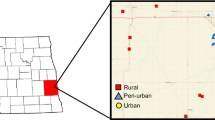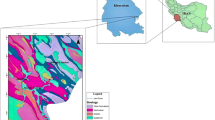Abstract
In Japan, since ancient times, numerous small- to medium-size agricultural ponds have been constructed to irrigate paddy rice fields. Economic growth and urbanization in the modern era have resulted in a decreasing agricultural land area. With the aging of farmers in the country and due to decreasing management efforts, the degradation of the quality of water and the ponds’ environment has become an emerging issue in many regions. This study was conducted to investigate the status of the quality of water in agricultural ponds in the Yamato Plain, the center of agriculture, politics, economy, and culture of Nara Prefecture, Japan. Water quality data from 71 ponds were collected during 2013 to 2017. The water quality parameters of interest were pH, DO, EC, TN, TP, COD, SS, and Chl.a. Of these, pH, DO, and EC were measured at sampling sites using a portable apparatus, while water samples were collected for the analysis of TN, TP, COD, SS, and Chl.a in the laboratory. The results of the water quality analysis indicated deteriorated pond water for use of agriculture and also for the environment. Principal component analysis was applied to the water quality data for the assessment of the degradation level of the ponds. Results from the analysis showed a dominance of organic contamination. The MCMC sampling method was then applied to develop a Bayesian multiple regression model to quantify the range of correlation between the water quality indicator and pond catchment land use pattern. The model revealed pond water deteriorated with an increased residential area in the catchment, while an increased forest area tends to have a positive effect on pond water quality. The model has the potential to be a useful tool for the management of the environmental quality of ponds.




Similar content being viewed by others
References
Fathy SAH, Abdel Hamid FF, Shreadah MA, Mohamed LA, El-Gazar MG (2012) Application of principal component analysis for developing Water Quality Index for selected coastal areas of Alexandria Egypt. Resour Environ 2(6):297–305
Giri S, Qiu Z (2016) Understanding the relationship of land uses and water quality in twenty first century: a review. J Environ Manag 173:41–48
Iwanaga R, Hatcho N, Matsuno N (2015) Application of water quality index for assessing water environment of irrigation reservoirs in Nara city (in Japanese). J Jpn Soc Water Environ 38(1):31–38
Jianqin M, Jingjing G, Xiaojie L (2010) Water quality evaluation model based on principal component analysis and information entropy: application in Jinshui River. J Resour Ecol 1(3):249–252
Kery M, Schaub M (2012) Bayesian population analysis using WinBUGS: a hierarchical perspective. Academic Press, Cambridge, p 554
MAFF (Ministry of Agriculture, Forestry, and Fisheries) (2014) Homepage. http://www.maff.go.jp/j/nousin/bousai/bousai_saigai/b_tameike/attach/pdf/index-19.pdf. Accessed 30 June 2018
Matsunuma K (2016) Bayesian statistical modeling using Stan and R: Wonderful R 2 (Japanese). Kyoritsu Publishing, Tokyo, p 264
Nagasaka S, Horino H, Watanabe T, Marutama T (1998) Water quality in irrigation ponds and evaluation using principal component analysis—a case study of the ponds in kyoto, shiga, and nara prefecture. Trans JSIDRE 194:321–327
OECD (Organization for Economic Cooperation and Development) (1982) Eutrophication of waters, monitoring assessment and control. Final report, OECD Cooperative Programme on Monitoring of Inland Water (Eutrophication Control), Environment Directorate, OECD, Paris, 154p
Parinet B, Lhote A, Legube B (2004) Principal component analysis: an appropriate tool for water quality evaluation and management—application to a tropical lake system. Ecol Model 178:295–311
PWG (Pollution Working Group of the Ministry of Agriculture, Forestry, and Fisheries) (1970) Water Quality Standard for Agricultural Water (Paddy Rice) (Japanese). http://www.maff.go.jp/j/seisan/kankyo/hozen_type/h_sehi_kizyun/pdf/02060111shiryou2.pdf. Accessed 10 July 2018
Sahooa MM, Patrab KC, Khatuac KK (2015) Inference of Water Quality Index using ANFIA and PCA. Aquat Procedia 4:1099–1106
Shi P, Zhang Y, Li Z, Li P, Xu G (2017) Influence of land use and land cover patterns on seasonal water quality at multi-spatial scales. CATENA 151:182–190
Yua S, Xua Z, Wuc W, Zuo D (2016) Effect of land use types on stream water quality under seasonal variation and topographic characteristics in the Wei River basin, China. Ecol Ind 60:202–212
Acknowledgements
This study was carried out as part of research on water quality monitoring and development of conservation measures supported by Nara Prefecture from 2016 to the present. We acknowledge water user groups and farmers of studied ponds for their support and understanding of our activity.
Author information
Authors and Affiliations
Corresponding author
Rights and permissions
About this article
Cite this article
Matsuno, Y., Kishi, Y. & Hatcho, N. Assessment of water quality in small agricultural ponds in Nara, Japan. Paddy Water Environ 17, 523–530 (2019). https://doi.org/10.1007/s10333-019-00748-9
Received:
Revised:
Accepted:
Published:
Issue Date:
DOI: https://doi.org/10.1007/s10333-019-00748-9




